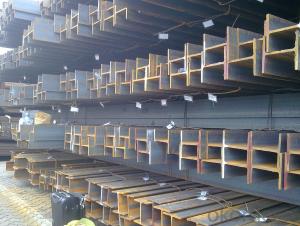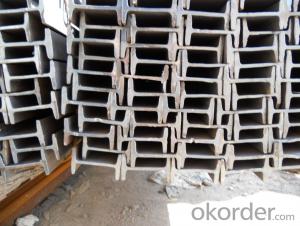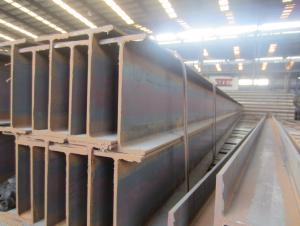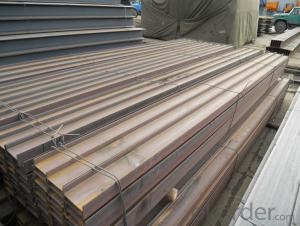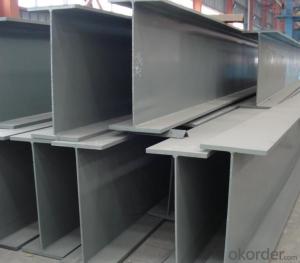H Beam with Kinds of Production Standards and Good Quality for Sale
- Loading Port:
- Tianjin
- Payment Terms:
- TT OR LC
- Min Order Qty:
- 25 m.t.
- Supply Capability:
- 20000 m.t./month
OKorder Service Pledge
OKorder Financial Service
You Might Also Like
Item specifice
Product Description:
OKorder is offering H Beam with Kinds of Production Standards and Good Quality for Sale at great prices with worldwide shipping. Our supplier is a world-class manufacturer of steel, with our products utilized the world over. OKorder annually supplies products to European, North American and Asian markets. We provide quotations within 24 hours of receiving an inquiry and guarantee competitive prices.
Product Applications:
H Beam with Kinds of Production Standards and Good Quality for Sale are ideal for structural applications and are widely used in the construction of buildings and bridges, and the manufacturing, petrochemical, and transportation industries.
Packaging & Delivery:
Packaging Detail: products are packed in bundle and then shipped by container or bulk vessel, deformed bar is usually naked strapping delivery, when storing, please pay attention to moisture proof. The performance of rust will produce adverse effect.
Each bundle weight: 2-3MT, or as required
Payment term: TT or L/C
Delivery Detail: within 45 days after received advanced payment or LC.
Label: to be specified by customer, generally, each bundle has 1-2 labels
Trade terms: FOB, CFR, CIF
FAQ:
Q1: Why buy Materials & Equipment from OKorder.com?
A1: All products offered byOKorder.com are carefully selected from China's most reliable manufacturing enterprises. Through its ISO certifications, OKorder.com adheres to the highest standards and a commitment to supply chain safety and customer satisfaction.
Q2: How soon can we receive the product after purchase?
A2: Within three days of placing an order, we will begin production. The specific shipping date is dependent upon international and government factors, but is typically 7 to 10 workdays.
Q3: How do we guarantee the quality of our products?
A3: We have established an advanced quality management system which conducts strict quality tests at every step, from raw materials to the final product. At the same time, we provide extensive follow-up service assurances as required.
Images:

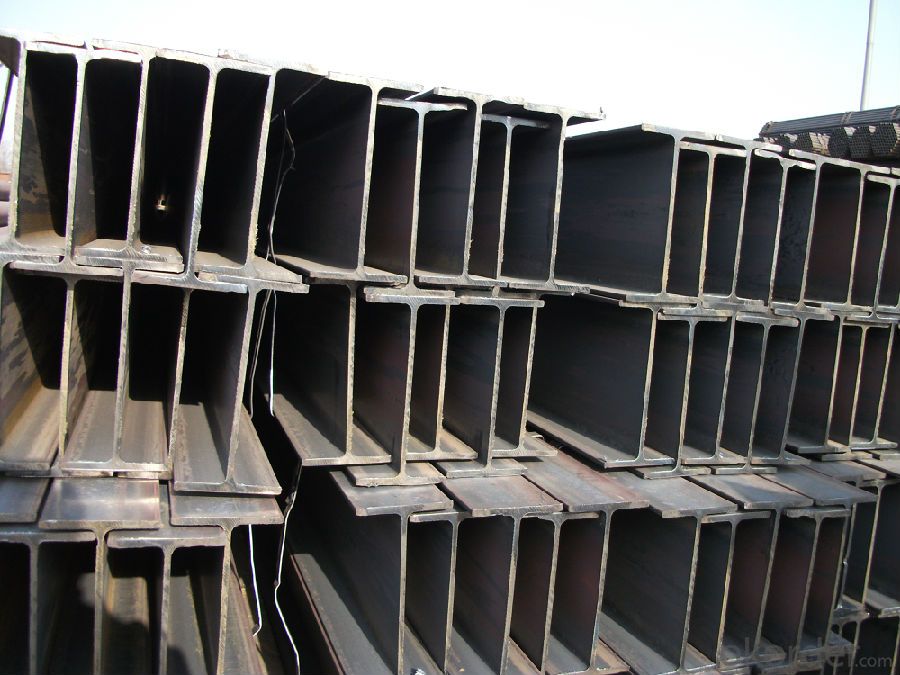
- Q:Can steel H-beams be used in marine environments?
- Steel H-beams are suitable for marine environments, but they need to be protected and maintained to prevent corrosion. Marine environments are known for their high moisture levels, exposure to saltwater, and harsh weather conditions, all of which can speed up the corrosion process of steel. To reduce these risks, steel H-beams used in marine environments should be constructed from corrosion-resistant materials like stainless steel or galvanized steel. Stainless steel is particularly well-suited for marine environments because of its strong resistance to corrosion and rust. It contains a significant amount of chromium, which develops a thin, passive layer on the surface of the steel, shielding it from the corrosive effects of saltwater and moisture. Stainless steel H-beams can withstand the tough marine environment without significant deterioration, making them a popular choice for piers, bridges, and offshore structures. Galvanized steel is another viable option for marine environments. It is carbon steel that has been coated with a layer of zinc, acting as a sacrificial barrier against corrosion. The zinc coating corrodes first, protecting the underlying steel from direct exposure to saltwater and moisture. However, galvanized steel may not be as long-lasting as stainless steel in highly corrosive marine environments, and the protective zinc coating can wear off over time, necessitating periodic maintenance and reapplication of the coating. Regardless of the steel type used, regular maintenance and inspections are crucial to ensure the integrity of H-beams in marine environments. This involves regular cleaning to eliminate salt deposits, repainting or re-galvanizing as necessary, and promptly addressing any indications of corrosion or damage. Additionally, proper design considerations should be taken into account to accommodate the specific challenges presented by marine environments, such as tidal forces, wave impact, and temperature fluctuations. In conclusion, steel H-beams can be used in marine environments if they are made from corrosion-resistant materials like stainless steel or galvanized steel and are adequately maintained. With the appropriate precautions, these beams can endure the harsh conditions of marine environments, making them a dependable choice for various marine structures and applications.
- Q:Are there any health concerns associated with Steel H-Beams?
- Yes, there can be health concerns associated with Steel H-Beams. Steel H-Beams are typically made from carbon steel, which contains trace amounts of elements such as lead, chromium, and nickel. These elements may pose health risks if they are released into the environment or if individuals come into direct contact with them. One potential health concern is lead poisoning. Lead is a toxic heavy metal that can cause serious health issues, especially in children. If lead is present in the steel beams and is released into the air or water, it can contaminate the surrounding environment and pose a risk to human health. Another concern is the presence of chromium and nickel. These metals can cause allergic reactions and skin irritation in individuals who are sensitive to them. Direct contact with steel beams containing these metals can lead to dermatitis or other skin conditions. Furthermore, steel production and processing involve the use of various chemicals and substances that can be harmful if not properly handled and disposed of. For example, the welding process used to fabricate steel beams may release toxic fumes, such as zinc oxide or manganese, which can have adverse effects on respiratory health if inhaled. It is important to note that the health risks associated with Steel H-Beams can be minimized through proper handling, storage, and disposal practices. Employers and workers who come into contact with steel beams should be educated about the potential health hazards and take necessary precautions to protect themselves. Additionally, environmental regulations and safety standards should be followed to ensure that steel production processes do not pose a risk to human health or the environment.
- Q:300 * 150 * 6.5 * 9 H steel is used as steel beam, span 6 meters, spacing 2 meters, laying steel plate, 15 cm soil
- The concrete strength grade of the slab does not know, the reinforcement does not know, the bearing capacity of the board can afford, it can not be calculated.
- Q:How do steel H-beams perform in coastal environments?
- Steel H-beams perform well in coastal environments due to their inherent resistance to corrosion. The steel used in H-beams is often coated or galvanized, providing an extra layer of protection against the corrosive effects of saltwater and humidity. This makes them highly durable and capable of withstanding the harsh conditions typically found in coastal areas, making them an ideal choice for construction projects in such environments.
- Q:How do steel H-beams perform in bridge expansions or contractions?
- Steel H-beams are widely used in bridge construction due to their excellent performance during expansions or contractions. These beams have high tensile strength and flexibility, allowing them to withstand the forces caused by temperature variations. As the bridge expands or contracts due to temperature changes, the steel H-beams can adjust their shape accordingly without compromising the structural integrity of the bridge. This ability to accommodate thermal movements makes steel H-beams an ideal choice for bridges, ensuring their stability and longevity over time.
- Q:How do steel H-beams perform in extreme temperatures?
- Due to their high thermal conductivity and low thermal expansion coefficient, steel H-beams exhibit excellent performance in extreme temperatures. This enables them to efficiently disperse heat and withstand deformation resulting from thermal expansion and contraction. Moreover, steel possesses a high melting point, rendering it suitable for deployment in extreme temperature environments. Nevertheless, it is crucial to highlight that prolonged exposure to exceedingly high temperatures may gradually weaken the steel, leading to a loss of structural integrity. Therefore, it becomes imperative to carefully assess the performance of steel H-beams in extreme temperatures by considering the specific temperature range and duration of exposure.
- Q:Can steel H-beams be used in cold storage or refrigeration facilities?
- Steel H-beams are indeed suitable for use in cold storage or refrigeration facilities. Their strength and durability make them a popular choice in construction. In these facilities, where low temperatures are maintained, steel H-beams offer the necessary structural support. They can withstand the temperature fluctuations and extreme conditions associated with refrigeration, making them highly suitable for these environments. Moreover, steel's excellent thermal conductivity allows for efficient heat transfer, ensuring that the desired temperature levels are maintained in the cold storage or refrigeration facility.
- Q:What are the different grades of steel used in manufacturing H-beams?
- There are several different grades of steel that are commonly used in manufacturing H-beams. These grades are classified based on their mechanical properties and chemical composition. One of the most commonly used grades is ASTM A36, which is a low carbon steel. It has good strength and ductility, making it suitable for a wide range of applications. Another commonly used grade is ASTM A572, which is a high-strength, low alloy steel. It provides excellent strength-to-weight ratio and is often used in heavy construction projects. Other grades that are frequently used include ASTM A992, which is a structural steel with enhanced corrosion resistance, and ASTM A588, which is a high-strength, low alloy steel with improved atmospheric corrosion resistance. The choice of grade depends on the specific requirements of the H-beam, including the desired strength, durability, and resistance to corrosion. Factors such as the load-bearing capacity, environmental conditions, and intended use of the H-beam also influence the selection of the appropriate grade of steel. It is important to consult the relevant industry standards and specifications, as well as the expertise of engineers and manufacturers, to determine the most suitable grade of steel for manufacturing H-beams in a particular application.
- Q:How do steel H-beams perform in areas with high snow load?
- Steel H-beams are known for their exceptional strength and durability, making them well-suited for areas with high snow loads. The H-shaped profile of these beams provides increased structural stability, allowing them to effectively withstand the weight and pressure exerted by heavy snow accumulation. One of the key advantages of steel H-beams in snowy regions is their high load-bearing capacity. The H-shape design distributes weight evenly across the beam, reducing the risk of bending or deformation under intense snow loads. This ensures that the structural integrity of buildings or structures remains intact, mitigating the potential risks associated with heavy snowfall. Moreover, steel H-beams have excellent resistance to bending, twisting, and shearing forces. These properties make them highly reliable and capable of withstanding the dynamic loads imposed by snow loads, such as the weight of snow sliding off a roof or the impact of strong winds combined with snowfall. Additionally, steel H-beams are known for their resistance to corrosion, which is particularly important in areas with high snow loads. Snow can contain moisture that may penetrate the structural components of a building, potentially leading to rusting and weakening of the material. However, steel H-beams are typically coated with protective layers or galvanized to prevent corrosion, ensuring their long-term performance and structural integrity in harsh snowy environments. In summary, steel H-beams are an excellent choice for areas with high snow loads due to their superior strength, load-bearing capacity, resistance to deformation, and corrosion resistance. These beams provide a secure and durable structural support system, ensuring the safety and stability of buildings and structures under heavy snowfall conditions.
- Q:Can steel H-beams be used in cold storage facilities?
- Indeed, cold storage facilities can utilize steel H-beams. These beams are frequently employed in construction due to their robustness and endurance, rendering them well-suited for a multitude of purposes, including cold storage facilities. The distinctive H shape of these beams grants them exceptional load-bearing capabilities, enabling them to bear substantial burdens such as insulation panels and refrigeration equipment. Furthermore, steel exhibits remarkable resistance to temperature fluctuations and can endure the frigid temperatures commonly encountered in cold storage facilities without compromising its structural integrity. Consequently, steel H-beams present a fitting option for construction within cold storage facilities.
1. Manufacturer Overview |
|
|---|---|
| Location | |
| Year Established | |
| Annual Output Value | |
| Main Markets | |
| Company Certifications | |
2. Manufacturer Certificates |
|
|---|---|
| a) Certification Name | |
| Range | |
| Reference | |
| Validity Period | |
3. Manufacturer Capability |
|
|---|---|
| a)Trade Capacity | |
| Nearest Port | |
| Export Percentage | |
| No.of Employees in Trade Department | |
| Language Spoken: | |
| b)Factory Information | |
| Factory Size: | |
| No. of Production Lines | |
| Contract Manufacturing | |
| Product Price Range | |
Send your message to us
H Beam with Kinds of Production Standards and Good Quality for Sale
- Loading Port:
- Tianjin
- Payment Terms:
- TT OR LC
- Min Order Qty:
- 25 m.t.
- Supply Capability:
- 20000 m.t./month
OKorder Service Pledge
OKorder Financial Service
Similar products
New products
Hot products
Related keywords
